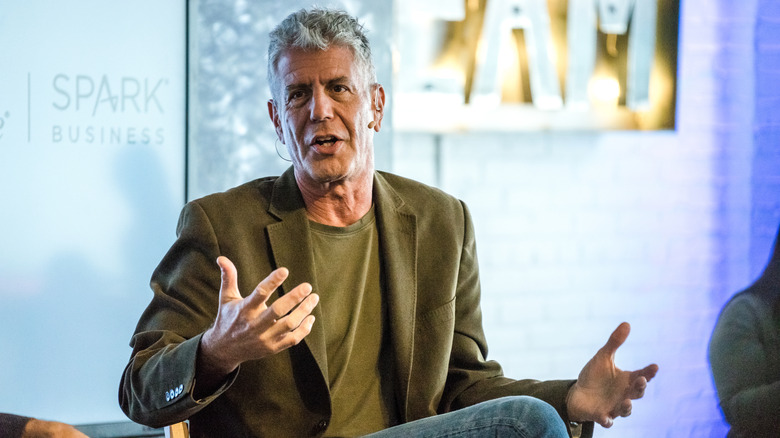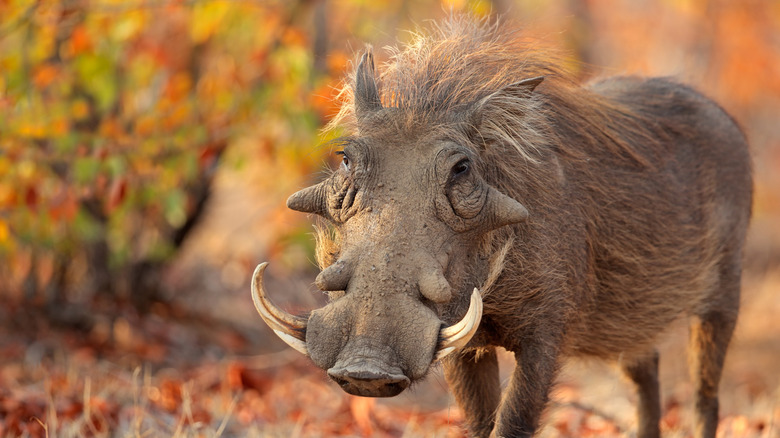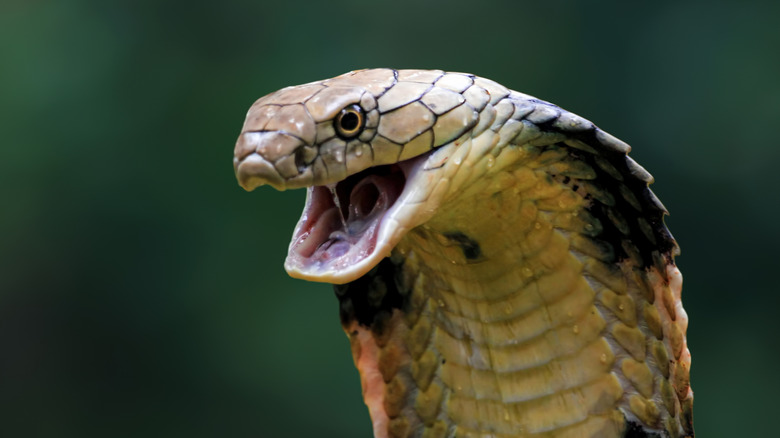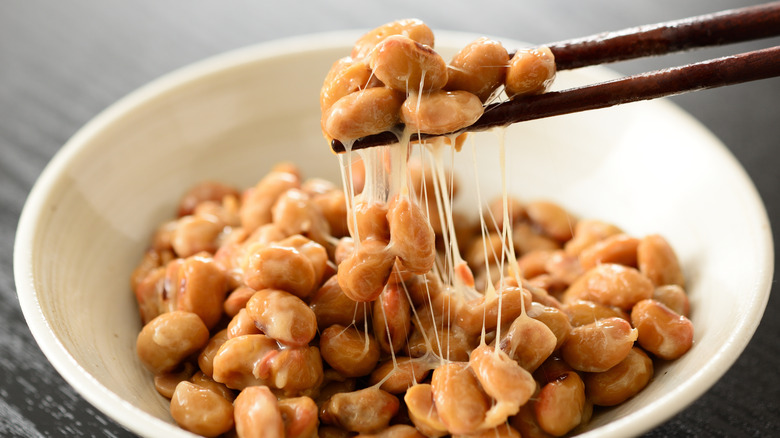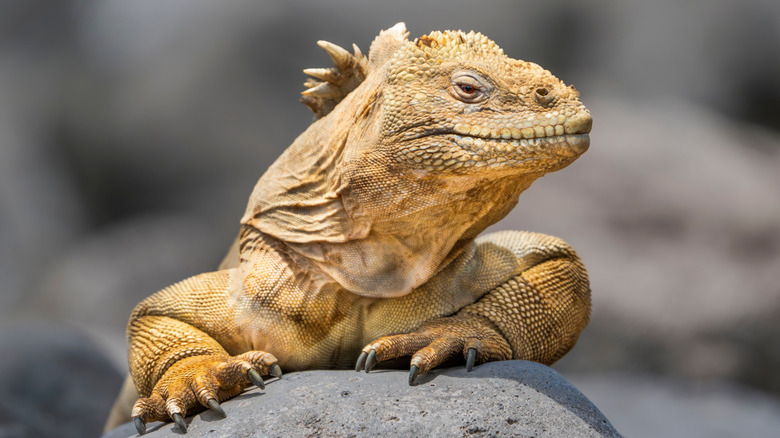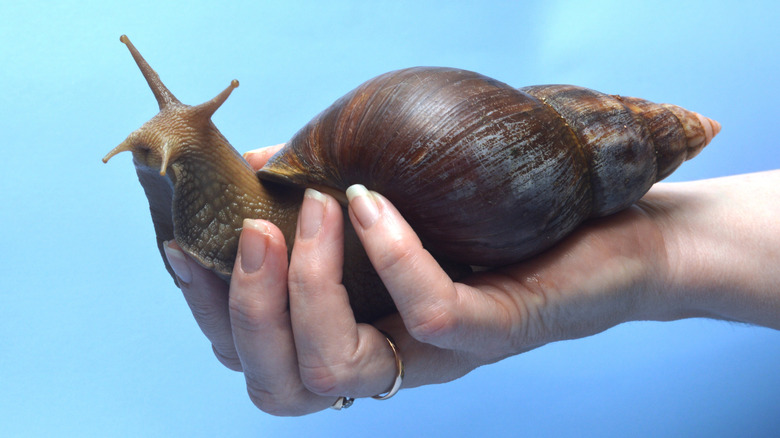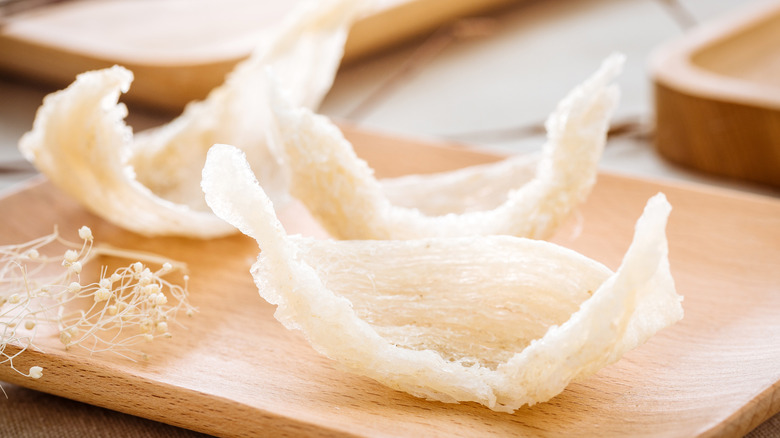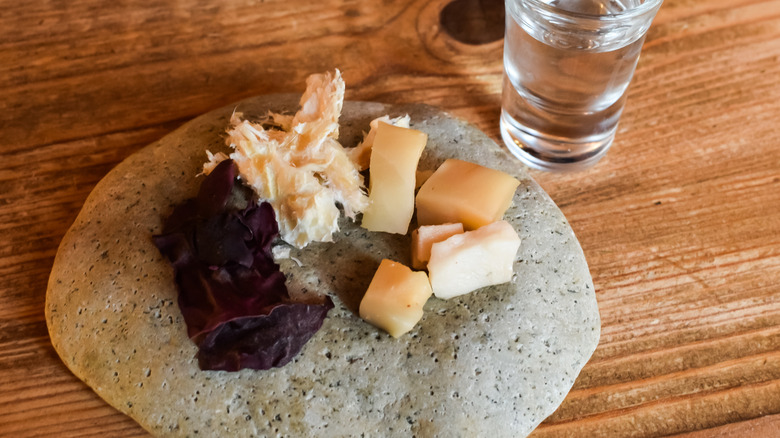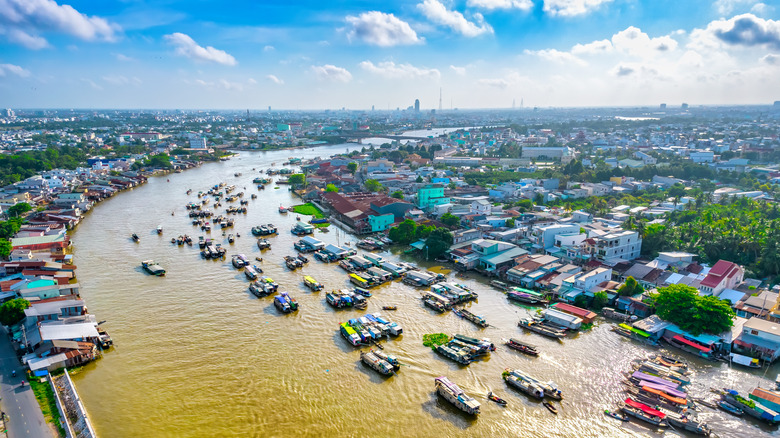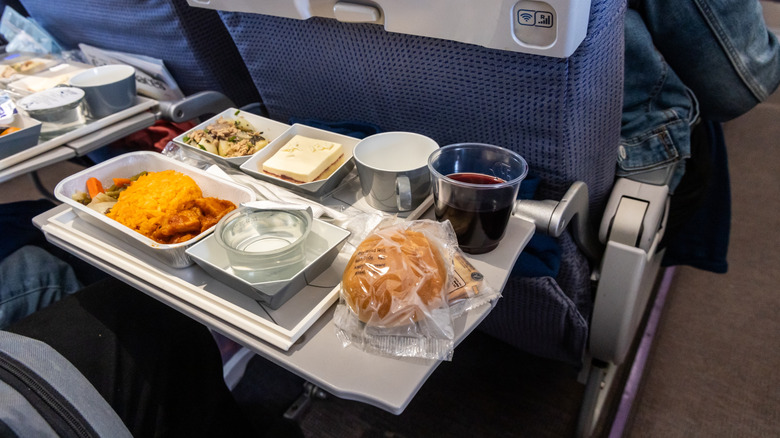Anthony Bourdain's Least Favorite Dishes Of All Time
We may receive a commission on purchases made from links.
Anthony Bourdain had a galvanizing willingness to step outside of his comfort zone. It was one of the traits that made him an icon, although more than a few times it came at the expense of his own stomach's stability, as he tried questionable (sometimes even parasite-ridden) dishes that made him ill on more than one occasion. Nevertheless, he maintained a message of positivity. "You'll never get the truly great meals of your life if you don't leave yourself open to the bad ones," he said after a particularly gruesome meal in the Namibia episode of "No Reservations."
Although the traveling chef ate a shocking array of animal parts, bugs, and things you wouldn't have even thought were edible, there were a few lines laid down by his first wife that he never seemed to cross. In his book "A Cook's Tour," Anthony describes getting ready to begin his TV career with Nancy, his wife, saying "I hear of you scooping the brains out of some cute little monkey's head while he's still alive? It's divorce court ... And try to lay off the dog and cat." With those stipulations, he set out to eat pretty much everything else — and we mean everything.
Many of the craziest things Bourdain ate weren't necessarily his least favorite meals. Some dishes that may sound utterly unappetizing — like raw seal eyeballs — didn't seem to faze him. Given the things he ate and didn't mind, it becomes apparent that the dishes that did sicken him must've been truly terrible.
Warthog anus
This one really doesn't need much explanation. It's hard to believe that anyone would eat the anus of a warthog — unwashed, by the way — and think it was anything but the worst thing they'd ever eaten. The episode of "No Reservations" filmed in Namibia is a gruesome ordeal to witness. It starts off with the motley crew eating ostrich egg cooked in hot dirt for quite a long time, followed by the consumption of the warthog anus cooked for not nearly a long enough time. Anthony Bourdain laments in the voiceover, "behold: the worst meal of my life."
The experience seemed to be a character-builder, though. He knew going into it that it wasn't going to be the best meal of his life. The Bushmen who hosted him survive in harsh desert environments on very little — you could hardly expect the meal to be extravagant. The point of the show, and this sort of episode in particular, was to meet people in less-traveled parts of the world and partake of their culture — to learn about how they eat and the food that keeps them alive. This particular cut of the warthog (an animal that takes a great deal of time and energy to hunt) is prized for its fat content, and by eating it Bourdain was making a point. "Lesson one as a traveler," he said, "food given as a gesture of hospitality is always gratefully accepted, always. Because no matter how weird or horrible it may seem to you, for someone else, it's their means of subsistence." This is similar to Bourdain's "Grandma Rule," a lasting piece of advice for travelers.
Cobra bile
While traveling in Vietnam, Anthony Bourdain once famously ate the freshly extracted, still-beating heart of a cobra on camera — an experience he relived in many interviews. The heart, cut out of the live animal by the somewhat nervous restaurant staff, was dumped in a small dish and placed before him to be consumed raw and unseasoned. He didn't hesitate when the crucial moment came, and stated rather enthusiastically in his book "A Cook's Tour:" "I'll be dining out on this story for a while." This gruesome act didn't faze the chef of 25 years, but the following five courses of cobra juices and bits certainly did.
The meal included an uneventful cobra soup, crunchy fried snake bones, end even a small glass of still-warm blood that didn't seem so bad either. But what came next, a vibrantly green bile mixed with wine, proved to be particularly disgusting to Bourdain. "It tastes bitter, sour, evil ... just like you'd expect bile to taste," he lamented in "A Cook's Tour." It's hard to imagine why anyone would want to taste bile, but even that wasn't the worst part.
The fluorescent bile was followed by a dish of tripe (which is stomach lining, if you didn't know) sautéed with onions, which he compared to eating a rubber dog toy — "but less tender." It's safe to say he wasn't itching to return to that restaurant, although he was certainly eager to share the harrowing story to many captive audiences.
Japanese natto
Natto is a simple dish of fermented soybeans that is traditionally eaten for breakfast in Japan, often mixed with soy sauce and raw egg and served over rice. It may, however, be an acquired taste for Western palates, as the soybeans get quite slimy and take on a potent flavor during the fermentation process. But if you can get over the strings of goop (and the smell), natto is chock-full of health benefits from the fermentation process, and is a great way to start your day.
Anthony Bourdain, unfortunately, did not find the dish so enjoyable. He ate it, among many other things, at a Ryokan in Japan, and detailed the experience in his book "A Cook's Tour." While he very much enjoyed the sake and multi-course menu the night before, the breakfast was not so much to his liking. "Nothing, not bugs, not iguana, not live reptile parts, not tree grubs, nothing I'd ever eaten would approach the horror of these few not unusual Japanese breakfast items." He lamented that, "all [he] wanted to do now was hurl [himself] through the paper walls and straight off the edge of the mountain."
Some of the meals Bourdain felt strongly negative about were consumed the day after he indulged in a large quantity of alcohol. Perhaps he would have had a different opinion about natto had it not followed a night of sake swilling — or if he had simply waited until his stomach had settled to give it a shot.
Iguana tamales
Iguana tamales are one of those dishes Anthony Bourdain didn't really want to eat. Some varieties of tamales come highly recommended (like these easy homemade tamales from Rick Martinez), but iguana is not one you often hear about. Iguana is often something people eat when they can't afford more delicious (and expensive) animals. Bourdain was coerced into chewing the rubbery bits by his producers who thought it would make for good TV — and, frankly, it did.
In "A Cook's Tour," Bourdain recalls that due to the last minute planning for the dish, the hotel's aged, leathery mascot was sacrificed for the meal. The results were less than appetizing. "Next to natto, it was maybe the worst thing I'd ever had between my teeth." He describes chewing for ages on the tough, flavorless meat, and feeling that the hotel's pet had been sacrificed in vain. "The texture was like chewing on a GI Joe — if Joe had been resting at the bottom of a long-neglected turtle tank." Perhaps it is best to keep iguana on the list of things to eat only if you're desperate. The ban on bushmeat in the U.S. may not be such a bad thing after all.
Giant African snail
The giant African snail is a massive land snail common to Western Africa, often growing as large as an adult human's fist. Given its size, these snails are a great source of protein. They are commonly eaten in countries like Ghana, Nigeria, and Côte d'Ivoire, either in peppery stews or grilled or fried in hearty chunks. But these snails can carry parasites, and if not prepared properly can make the person eating it very, very sick.
This worst case scenario was unfortunately what befell our dear Anthony Bourdain. While filming in Liberia for season 6 of "Parts Unknown," he became violently ill less than 6 hours after his last meal — which happened to be Achatina achatina, or giant African snail. Bourdain describes being so ill he was "crawling around on [his] hands and knees between bed and bathroom, praying to every known deity." With a reaction like that, it's unlikely anyone would ever be willing to come near the dish that caused it again.
While that particular snail may have taken Bourdain down for a few days, it shouldn't rule out the giant gastropod as a delicacy worth trying — just make sure it is properly cooked before you do. The giant snails are a great source of nutrients, and, just like normal-sized snails, they're easy to cook into tasty dishes — not to mention that giant snail farming has provided business opportunities to small-scale farmers.
Bird's nest soup
Bird's nest soup is a controversial delicacy originating in Chinese cuisine, its luxurious reputation owing to both the difficulty of acquiring it and its supposed health benefits. Preparation of the soup involves dissolving the bird's nest (a real nest gathered in the wild) into a broth. The pale white nest is made of solidified strings of saliva from the beak of the swiftlet bird, but that wasn't what threw Bourdain off. "The chunks are the problem," he cries in "A Cook's Tour," "It's disgusting. The nest tastes fine ... but when the pigeon's head, beak, eyes, and all, comes popping up between the eggs and dates and bones ... I've had enough."
His distaste of this particular dish, similar to his reaction to natto, may have been largely circumstantial. He had just finished a massive feast (and a generous number of beers) at another location before his producer insisted he eat bird's nest soup for the camera. On top of that, it was prepared in the same hotel kitchen that had taken a member of the TV show's crew down with violent food poisoning just the day before. These circumstances may have soured his opinion of the dish, which isn't always prepared with the whole bird hacked up into chunks; sometimes it's just the nest in a sweet-and-sour broth.
Fermented shark
Hákarl, an Icelandic fermented shark dish, has grown from obscurity into full-blown world renown — though not for its universal appeal. This dish may have kept people alive through harsh winters in the time of the Vikings, but nowadays it's a bit more difficult to stomach. That said, it is still celebrated in Icelandic culture (and is one of the unique dishes you have to try in Iceland). Anthony Bourdain, however, was not a fan. On "No Reservations" he proclaimed hákarl "probably the single worst thing I have ever put in my mouth," and in an interview with Conan O'Brien he described the discouraging image of cooks holding pieces of the stinking meat at arm's length with rubber-gloved fingers.
The late chef tried the questionably-prepared shark meat in the first episode of "No Reservations," where he noted that the shark meat was "buried underground and allowed to basically rot for 6 months." He partook of this delicacy, along with many others, at the yearly Thorrablot festival in Iceland, which celebrates the nation's culture, history, and delicacies. Regrettably, many of the unique dishes didn't seem too appetizing to Bourdain (with the exception of the sheep's testicles, which he seemed to enjoy). After finishing his meal at the festival he bemoaned the overall dining experience as being the "worst meal ever." It's safe to say that the traditional foods passed down by people surviving in extremely harsh environments may not end up being the most delicious plates in the world.
Exotic meats
Vietnam was at the top of the list of Anthony Bourdain's favorite countries to visit. While many of Bourdain's all-time favorite dishes came from the Southeast Asian country, he had some terrible experiences there as well. In "A Cook's Tour" he describes visiting a restaurant in Cần Thơ that closely resembled a petting zoo. Usually playing host to wealthy visitors from China, this particular restaurant offered a broad selection of exotic animals guests could choose from to be slaughtered for their dinner.
"I lose my appetite as soon as I see the sun bear," Bourdain wrote. "There are snakes, bats, lizards, crocodiles, cranes, an eighty-kilo python, monkeys, and dogs." Bourdain and his dinner guest opted to fish for their meal from an algae-coated lake, from whence they pulled up a couple of elephant fish. The fish may not have been cooked properly, though more likely it was the zoo-like environment that made for an abysmal dining experience for Bourdain. After the meal he suggested, "no one should come here."
Airplane food in general
Out of all of Anthony Bourdain's least favorite dishes, this one certainly seems the most mild. His distaste for airplane food may have been largely circumstantial — why eat subpar food on the plane ride to another country, when you know that once you land you'll be feasting on delicacies all day? "I don't eat on planes. I like to arrive hungry," he told Bon Appétit in an interview.
For a chef who traveled all the time with the intention of eating as much as possible once on the ground, all those airplane rides may have become monotonous. In the book "In The Weeds," Bourdain's longtime producer Tom Vitale described how Bourdain really didn't like flying, though largely due to the fact that he was a smoker. The prolonged periods without a cigarette proved difficult for him, and his preferred method for coping was to take some sleeping pills and pass out for the duration of the flight. In so doing, he simultaneously dealt with his nicotine withdrawal and avoided the smell of a microwaved platter of airplane food.
